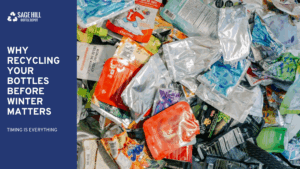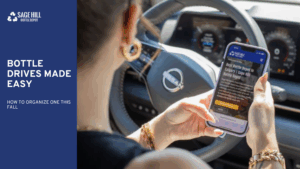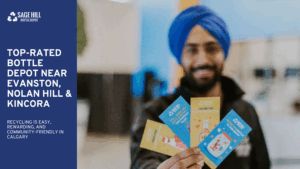Where Does Your Recycling Go?

The Surprising Journey of Containers
What happens to recycled containers after they leave our depot? The answer is more fascinating than you might think! Recycling is a complex process and understanding it can help us make better environmental choices.
Aluminum cans can be recycled and back on store shelves within 60 days. Over 95% of its weight is recycled, making it one of the most efficient materials to repurpose. The remaining material, usually wire, strapping, moisture, or contaminants, is minimal. This closed-loop recycling process not only saves energy but also reduces the need for mining new aluminum, making a cornerstone of sustainable living.
Clear plastic beverage containers have a second life that’s both functional and fashionable. These containers are shredded into flakes or pellets, which are then used to manufacture new food-grade beverage containers and they’re also transformed into clothing. That’s right, that polyester shirt you’re wearing could very well be made from recycled clear plastic bottles. It’s an impressive testament to the versatility of plastic recycling.
While coloured plastic containers can’t be used for food products, they have plenty of other uses. Recycled into pellets, these containers are reborn as non-food plastic products. Think park benches, plastic lumber, and more. This keeps plastic out of landfills and gives it a new purpose.
Glass recycling is a bit more straightforward but no less important. Glass containers are crushed into tiny beads, which are then spun into fibreglass insulation for homes here in Alberta. Elsewhere, these beads are used for sandblasting or added to street paint to increase reflectivity. It’s a shining example of how glass can be endlessly recycled without loss of quality.
Tetra Brik containers are a bit more complex, composed of paper, aluminum, and plastic. During the recycling process, they undergo hydro-pulping to separate these materials. About 80% of the paper content is recycled into new paper products, while remaining aluminum and plastic are also repurposed. It’s a comprehensive approach to recycling that ensures nothing goes to waste.
Gable Top cartons, like milk or juice cartons, also undergo hydro-pulping. Around 80% of the paper pulp is recycled into bath tissue, cardboard, and writing paper. The separated plastic is used in various other products, proving that even complex packaging can be effectively recycled.
Bi-Metal beverage containers find new life in the construction industry. Melted down, they are transformed into construction rebar, car parts, and mining grinding rods. It’s a robust second act that highlights the durability and versatility of metal recycling.
Drinking pouches and bag-in-box bladders are repurposed as alternative fuel sources due to limited end-use markets. The coarse cardboard package from BIB is recycled into products like egg cartons and cardboard boxes, showing that even the most challenging materials can be recycled effectively.
We’re committed to making recycling easy and efficient for everyone in Calgary. By understanding the journey of your beverage containers, you can see the significant impact your recycling efforts make. So, next time you have a pile of empties bring them to use and be part of a sustainable future!
Related Posts
Why Recycling Your Bottles Before Winter Matters
Timing is Everything That crisp, fresh autumn air turns to chilly cold a little too quickly for our liking. We…
Bottle Drives Made Easy
How to Organize One This Fall Hey Calgary, are you looking for simple and effective fundraiser ideas this fall? We…
Top-Rated Bottle Depot Near Evanston, Nolan Hill & Kincora
Recycling is Easy, Rewarding, and Community-Friendly in Calgary If you’re searching for the top-rated bottle depot near Evanston, Nolan Hill,…



